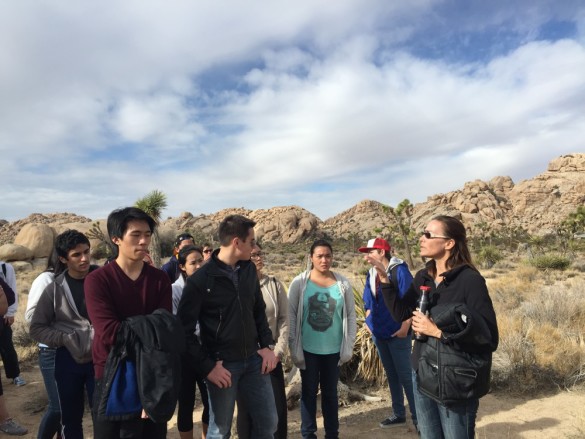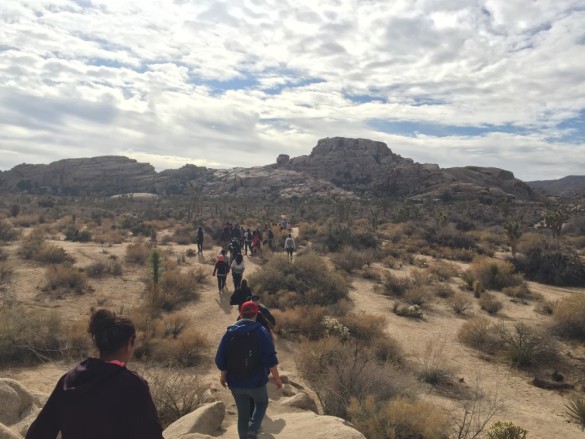Students hike through Joshua Tree National Park. Photo by Anisah Ullah
By Anisah Ullah, staff writer
AP Environmental Science students, along with teacher Lisa Battig and adult chaperones, went on an annual fieldtrip to Joshua Tree National Park for a field study on Saturday.
Every year, Battig offers the Joshua Tree National Park trip as an option for a field study project. Students venture to the desert accompanied by Battig herself and several parents. The trip allows for students to have a higher understanding of what they learned in class.
“It’s an opportunity for the students to get out in the field. It’s an opportunity for them to see one of the very, some what local, but different ecosystems that exists here in Southern California. It’s a true high desert ecosystem and they’re able to become acquainted with some very ancient geology and be able to see the results of some very powerful geologic forces,” said Battig.
The group, which included 35 students and 12 adults, took the 3 hour long drive to the National Park at 6am. The first stop was the Oasis Visitor Center where students went on a Phenology walk and gathered data on different plants. The students’ data was then contributed to a national database.
“I think the value in being able to take data that’s actually going to go into a national database and be used to find findings one day, and that it came from data that the students collected, that’s pretty phenomenal. That probably was my favorite part of this year’s trip,” said Battig.
Soon after they went to Key’s Lookout, which gave the students an overview of mountains, landmass, and the San Andreas fault, the students learned about various geologic forces that encompassed the desert area.
“It’s just refreshing to be in such an open place and view a landscape that hasn’t been infested with buildings and highways,” said Judy Beik(‘15).
After a long day of fun and learning, the students and parents were given time to climb some more boulders before it was time to head back to Fountain Valley.
“It really amazed me to see the weathering of all the rocks and Joshua trees. Especially when we got to climb and explore the huge boulders up close and personal,” said Michelle Truong(‘15).
Battig’s favorite aspect of the trip was seeing the student enjoyment and the connections made to concepts discussed in the classroom.

Photo by Anisah Ullah
“My favorite part really is seeing the students enjoy it. I think seeing people’s attitudes toward the desert change, because I think initially the assumption is that it’s going to be really boring,” said Battig. “But then they get to see how unique and how different it is. I think there’s a lot of learning and a lot of connections that are made.”
For the students, the trip was a fun and effective way for students to be able to connect what they learned in class to real life.
“I loved that we were able to learn outside in such a vast place, instead of just inside a small classroom. Witnessing everything we talked about in real life helped me become much more aware of the effect we have on the environment,” said Christine Le(‘15).






